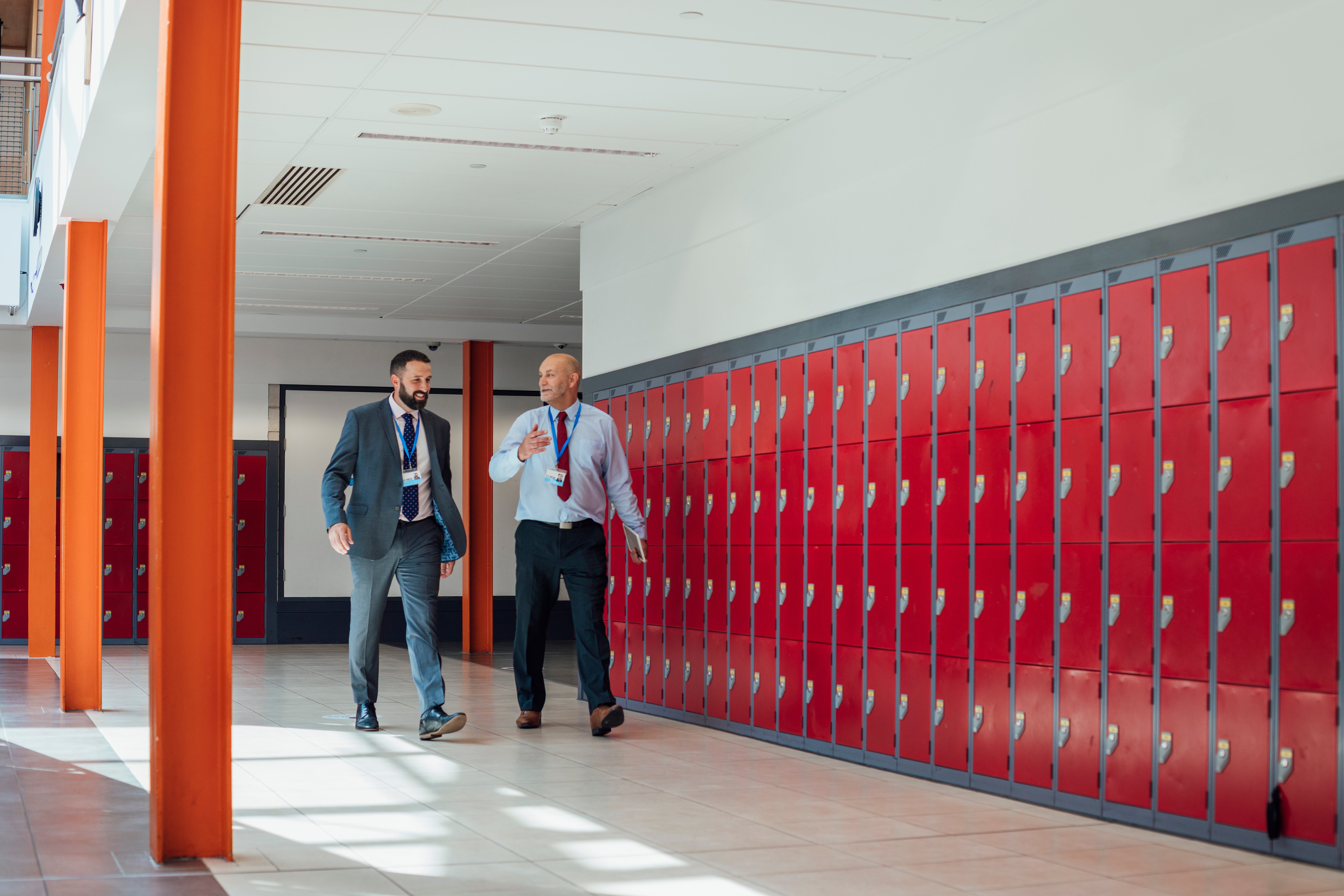School principals are working an average of 58 hours per week—and nearly 30% of that time is consumed by administrative tasks like paperwork, scheduling, and email. To lighten the load, 60% of teachers and principals have already turned to AI for support.
For principals, the goal is clear: automate routine tasks, uncover key trends, give time back to teachers, and identify early warning signs for attendance and behavior challenges. As interest in AI grows, many school leaders are looking for clear, practical ways to integrate it into their daily operations.
This post breaks down how principals can use AI to reduce administrative burden and refocus their time on what matters most: instruction, school culture, and supporting their staff.
Download 100+ AI Prompts for School Teams
How Does AI Help Principals?
AI is opening up new possibilities for how principals support their schools. By automating paperwork, generating reports, and analyzing student data, AI helps bring some much-needed balance back to their work lives.
Some principals use AI to draft emails and organize schedules, while others rely on it to track attendance patterns, monitor academic performance, and identify trends in student behavior..
With AI-powered tools, principals can offer teachers more support with personalized instruction, recommend timely interventions, and help educators adapt lessons to meet the needs of every student.
Here are a few of the ways principals are using AI to make their jobs more manageable—and their schools more effective.
Common AI Use Cases for Principals in K-12
As AI becomes more common in K–12 schools, it’s consistently helping principals make data-informed decisions, streamline communication, and manage resources more effectively.
Here are a few other ways principals are using AI to support their schools and teams.
- Reducing Paperwork: AI automates routine administrative tasks like scheduling, report generation, and email drafting—freeing up time for principals and teachers to focus on students.
- Identifying Student Needs: By analyzing patterns in attendance, grades, and behavior, AI helps surface early warning signs and highlight students who may need extra support.
- Supporting Lesson Planning and Communication: AI can generate draft lesson plans, progress summaries, and family communication templates, making it easier for educators to share updates and stay connected with caregivers.
- Recommending Strategies: Based on student data, AI suggests evidence-based interventions that align with individual learning and behavioral needs.
- Protecting Student Data: AI tools designed for education follow strict security protocols to safeguard student privacy and ensure compliance with FERPA and other regulations.
- Maintaining Educator Oversight: While AI provides helpful insights, it doesn’t replace professional judgment. Educators remain in control of decisions around instruction, support, and interventions.
How Principals Use AI in Schools
Principals are also using AI to track professional development needs, support hiring decisions, coordinate district initiatives, manage school logistics, and ensure all students have access to the resources and support they need. In addition, AI is helping principals in the following ways:
1. Automating Administrative Tasks
AI can help reduce the time principals spend on routine paperwork and scheduling by:
- Reducing Administrative Work: AI cuts down the time principals spend on routine tasks like paperwork and scheduling, allowing them to focus more on leadership and student support.
- Automating Communication: AI drafts emails, generates reports, and summarizes key information for staff and families—streamlining repetitive communication tasks.
- Enhancing Messaging with AI Assistants: Principals use AI-powered chatbots and virtual assistants to draft announcements, refine outreach, and respond to common questions from families.
- Optimizing Scheduling: AI tools help coordinate meetings, adjust class schedules, and organize school events—reducing conflicts and giving principals more time for instructional leadership.
2. Supporting Data-Informed Decision-Making
AI empowers principals to analyze school data, uncover trends, and make more data-informed decisions that support students and staff. Here are a few key ways it’s making an impact:
- Personalized Learning: AI helps educators tailor instruction to individual student needs, promoting more effective and engaging learning experiences.
- Timely Interventions: By analyzing attendance, academic, and behavior data, AI supports early identification of students who may need targeted support.
- Improved Student Outcomes: Data-driven insights enable a more holistic approach to student success.
- Professional Development: AI can highlight patterns in instructional practice and performance, helping principals identify where educators may benefit from additional training or coaching.
3. Improving Communication and Engagement
AI can help principals strengthen communication with families and school staff while reducing administrative workload.
- Writing Newsletters and Staff Updates: AI supports principals by drafting school-wide messages, parent communications, and teacher feedback reports—saving time while maintaining clear, consistent messaging.
- Improving Collaboration: AI helps school leaders, teachers, and district administrators organize meeting notes, summarize key discussions, and keep strategic planning efforts focused and actionable.
4. Strengthening Personalized Learning and Student Support
AI helps schools develop targeted learning plans that support each student’s academic and behavioral growth.
- Providing real-time student insights: When securely integrated with district tools and data, AI can help to recommend personalized support strategies.
- Helping teachers create adaptive learning experiences: Schools can use AI-powered tools to tailor instruction and extend learning opportunities beyond the classroom.
- Monitoring student progress: AI can help identify gaps in learning and recommend specific interventions, allowing educators to adjust strategies before students fall behind.
Top Challenges of AI in Schools
AI offers powerful support for school leaders and educators—but it also comes with challenges that districts must navigate carefully. Protecting student data, maintaining transparency, and ensuring fairness in decision-making are critical concerns. To use AI responsibly, schools need clear guardrails around when and how it’s used, making sure technology enhances—not replaces—human judgment.
Privacy and Data Protection
- Schools collect and manage highly sensitive student information, making data security a top priority. While AI can enhance school operations, it also introduces new risks that districts must proactively address:
- Data Storage and Access: Schools need to ensure that AI vendors collect, store, and use student data in full compliance with FERPA, COPPA, and other privacy regulations.
- Risk of Data Breaches: AI systems that process large volumes of student data must be protected by robust security measures to prevent unauthorized access or misuse.
- Transparency in AI Models: Districts should ask vendors how their AI models handle student data—including whether that data is stored, retained, or used to train future algorithms.
Ensuring Fairness
AI must be used thoughtfully to ensure all students have access to resources and support. Without careful oversight, AI tools can reinforce existing biases and contribute to unequal educational outcomes.
- Bias in AI Recommendations: If AI models are trained on incomplete or biased data, they can unintentionally amplify disparities—resulting in unequal access to interventions, resources, or opportunities.
- Human Oversight in Decision-Making: While AI can offer valuable insights, final decisions about student support, placement, and services must remain in the hands of educators.
- Ongoing Monitoring for Fairness: Districts should establish regular review processes to monitor AI tools for unintended bias and make adjustments to ensure fair and consistent treatment of all students.
Maintaining Academic Integrity and Thinking Skills
As AI tools become more accessible, schools have an opportunity to evolve how they support student learning and evaluate understanding. The goal is not to eliminate AI—but to balance its use with strategies that promote original thinking and deeper learning.
- Promoting Academic Integrity: While the rise of AI-assisted plagiarism presents new challenges, it also encourages educators to revisit academic integrity policies and create clearer expectations for AI use in the classroom.
- Improving Assessment Practices: Traditional assessments may no longer fully capture student learning in an AI-enabled world. Schools are exploring alternative approaches—like project-based learning, oral assessments, and AI-assisted assignments that still require students to demonstrate critical thinking.
- Navigating AI Detection with Care: AI writing detectors can help flag potential issues but are not foolproof. To ensure fairness, educators should pair detection tools with context, conversations, and a focus on growth rather than punishment.
Actionable Solutions to AI Implementation Challenges
Schools can maximize the benefits of AI by developing clear policies, training staff, and ensuring transparency between parents, teachers, and district leaders.
Developing Clear AI Governance Policies
AI should support educators, not replace them. Schools need clear guidelines to ensure AI is used responsibly.
- Define Appropriate AI Use: Clearly outline where AI can support school operations—such as data analysis, scheduling, or lesson planning—and where human judgment must remain central, especially in areas like grading, student placement, and discipline.
- Ensure Human Oversight: Establish protocols that require educators and administrators to review AI-generated insights before taking action. AI should inform decisions, not make them.
- Prioritize Student Privacy: Work only with AI vendors who comply with education privacy laws like FERPA and COPPA, and demand transparency about how student data is stored, used, and protected.
Investing in Professional Development
Educators need structured training to use AI effectively in their schools. Without clear guidance, AI tools can be underutilized or misapplied.
- Offer hands-on training: Provide staff with workshops on AI tools for lesson planning, communication, and data analysis.
- Develop best practices: Create district-wide guidelines for AI use, including when it should and shouldn’t be used in the classroom.
- Encourage collaborative learning: Facilitate discussions between educators to share strategies and experiences with AI.
Why Panorama Education Is the Best Solution for AI in Schools
AI is becoming an essential tool in school leadership, helping administrators work more efficiently, make data-informed decisions, and better support students and staff. But to be effective, AI solutions must be tailored to the unique needs of K–12 education.
Panorama Solara was built with that in mind—a customizable, district-wide AI platform designed specifically for educators and administrators. It brings the power of AI into everyday workflows while keeping student data safe and educators in control.
Here's what sets Solara apart:
- Student Privacy at the Core: Solara protects student data by operating on a secure infrastructure without using the data to train AI models. This commitment ensures compliance with SOC 2 standards and the Student Privacy Pledge, offering educators and families peace of mind that their data is safe.
- Research-Backed Insights: Solara AI provides actionable, district-specific recommendations that align with educational best practices. These insights help educators implement targeted strategies that address students’ needs.
- Data Security: The platform maintains strict privacy standards and never uses sensitive student data for AI training, reinforcing trust among educators and administrators.
- Customization Options: Solara adapts to each district's unique needs, ensuring AI-generated recommendations are relevant to specific curriculum and teaching styles.
- Efficiency in Task Management: By automating time-consuming tasks like intervention planning and curriculum adjustments.
- Integration with Existing Tools: Solara complements Panorama's suite of tools, creating streamlined access to student success metrics and engagement data.
- Transparency in AI Use: Educators and administrators can monitor AI usage across districts using intuitive dashboards.
Learn how Panorama Solara helps principals and schools.







